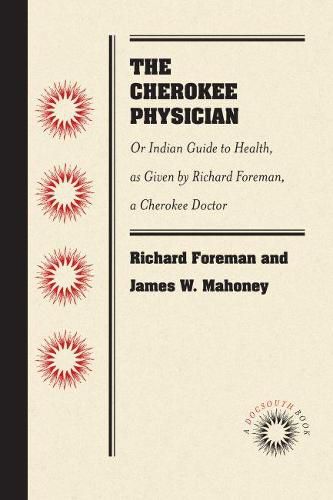Readings Newsletter
Become a Readings Member to make your shopping experience even easier.
Sign in or sign up for free!
You’re not far away from qualifying for FREE standard shipping within Australia
You’ve qualified for FREE standard shipping within Australia
The cart is loading…






The extended title of The Cherokee Physician serves as an apt summary of its contents. The book was the result of a remarkable collaboration between James Mahoney, an Irish American and native Tennesseean, and Richard Foreman, whose parental ancestry was probably Scottish and Cherokee. Typical of its time, the book dispenses moral advice as cheerfully as medical advice. Needless to say, much of its advice flies in the face of modern medical practice and should not be applied. Foreman and Mahoney warn against sitting by an open window and offer conjecture, now disproven, about the pathologies of illnesses such as yellow fever and undulant fever ( milk sickness ). On the other hand, some of its cures have come into vogue or else find modern scientific endorsement, with examples from the text including the anti-inflammatory properties of red pepper and the usefulness of the European plantain.
The volume has intrigued homeopathic practitioners through the years, and attracted the interest of contemporaneous practitioners, including, for instance, one doctor who wrote to the Therapeutic Gazette (September 1881) to enthusiastically endorse its cure for
gravel
through Gravel Weed (Actinomeris Helianthoides).
Gravel
translates to kidney stones in contemporary parlance; modern homeopathic sources say little about the common flower’s use as a diuretic, furnishing one example of knowledge in The Cherokee Physician that has escaped modern evaluation. The book offers, by slant, interesting ethnographic observations, equally unproven.
$9.00 standard shipping within Australia
FREE standard shipping within Australia for orders over $100.00
Express & International shipping calculated at checkout
The extended title of The Cherokee Physician serves as an apt summary of its contents. The book was the result of a remarkable collaboration between James Mahoney, an Irish American and native Tennesseean, and Richard Foreman, whose parental ancestry was probably Scottish and Cherokee. Typical of its time, the book dispenses moral advice as cheerfully as medical advice. Needless to say, much of its advice flies in the face of modern medical practice and should not be applied. Foreman and Mahoney warn against sitting by an open window and offer conjecture, now disproven, about the pathologies of illnesses such as yellow fever and undulant fever ( milk sickness ). On the other hand, some of its cures have come into vogue or else find modern scientific endorsement, with examples from the text including the anti-inflammatory properties of red pepper and the usefulness of the European plantain.
The volume has intrigued homeopathic practitioners through the years, and attracted the interest of contemporaneous practitioners, including, for instance, one doctor who wrote to the Therapeutic Gazette (September 1881) to enthusiastically endorse its cure for
gravel
through Gravel Weed (Actinomeris Helianthoides).
Gravel
translates to kidney stones in contemporary parlance; modern homeopathic sources say little about the common flower’s use as a diuretic, furnishing one example of knowledge in The Cherokee Physician that has escaped modern evaluation. The book offers, by slant, interesting ethnographic observations, equally unproven.